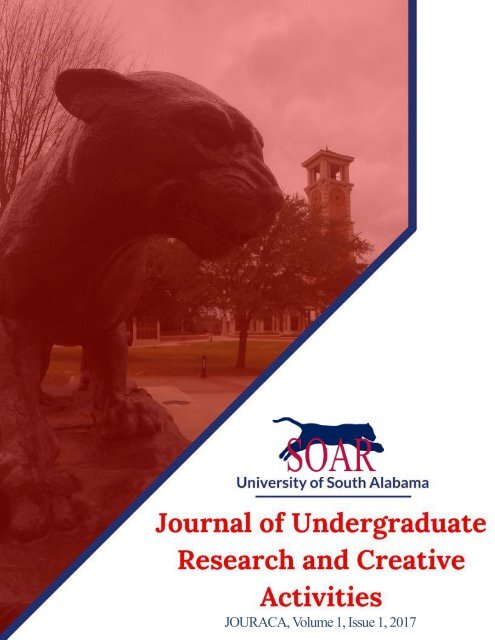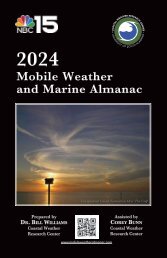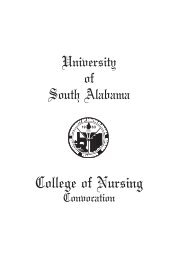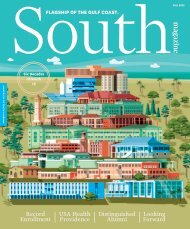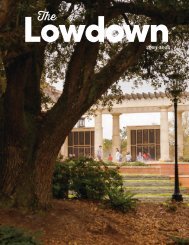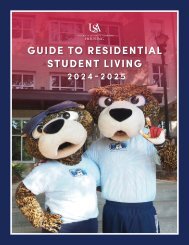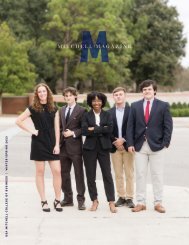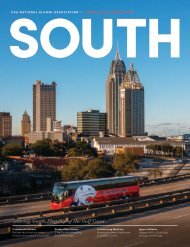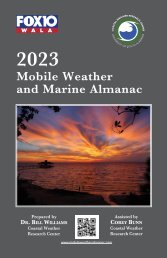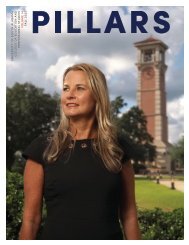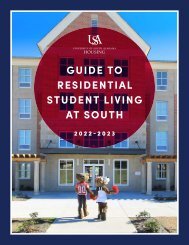JOURACA_SP_2017
Create successful ePaper yourself
Turn your PDF publications into a flip-book with our unique Google optimized e-Paper software.
<strong>JOURACA</strong>, Volume 1, Issue 1, <strong>2017</strong>
Table of Contents<br />
Welcome Statement by Dr. Al Chow<br />
ii<br />
A Letter from the Editors<br />
iii<br />
Scope of the Journal<br />
iv<br />
Aims of the Journal<br />
v<br />
Abstracts 1<br />
Closing Statement by Dr. Jack Shelley-Tremblay<br />
pg.<br />
i
Welcome,<br />
Research is the cornerstone of academic<br />
discovery. <strong>JOURACA</strong> is intended to provide<br />
a starting point for undergraduate<br />
publication. We will provide peer review<br />
to all submissions and give valuable feedback<br />
for beginning researchers. The journal<br />
will accept submissions from all types<br />
of creative endeavors, to include all students<br />
of the University community. By<br />
publishing online twice a year, <strong>JOURACA</strong><br />
will allow students to publish in a timely<br />
manner, allowing students to get their research<br />
out quickly, while maintaining copyright<br />
for future publication in discipline<br />
specific journals.<br />
I have mentored student research for many years, taking students to regional conferences to<br />
present their works. I have had many conversations related to publishing an online journal for<br />
student research for the better part of a decade. When Dr. Shelley-Tremblay brought up the<br />
concept last summer I jumped at the chance to participate, because I strongly feel that this is<br />
one of those things we are supposed to do at the University. I look forward to assisting this<br />
editorial staff in creating a quality publication, so that USA students will have a platform to<br />
show their work to the community and the world. We plan to develop and grow <strong>JOURACA</strong><br />
to meet the needs of the undergraduate research students.<br />
Alan F. Chow, Ph.D.<br />
Advisor to the Student Organization of Academic Research &<br />
Associate Professor of Quantitative Methods<br />
Department of Marketing and Quantitative Methods<br />
Mitchell College of Business<br />
ii
A Message from the Editors<br />
To have not only the opportunity to be funded as an undergraduate researcher,<br />
but to have an undergraduate journal is a notable triumph of the University of<br />
South Alabama. <strong>JOURACA</strong> will give less represented students an opportunity<br />
to showcase their research in a peer-reviewed, non-copyrighted journal. This<br />
journal will expand not only the opportunities of undergraduates to publish their<br />
original research, but also allow other students to view and draw inspiration<br />
from other students’ work.<br />
- Elizabeth Bemis<br />
SOAR President<br />
As Managing Editor for the Journal of Undergraduate Research and Creative<br />
Activities (<strong>JOURACA</strong>) and as Vice President for the Student Organization of<br />
Academic Research (SOAR), I see that <strong>JOURACA</strong> and SOAR are organizations<br />
founded by students for students. Our biggest goal is to provide students with<br />
more opportunities to publish their work and develop themselves professionally<br />
to promote their future careers and enable opportunities. We hope that our readers<br />
will take advantage of this opportunities and gives us editors plenty of late<br />
nights working getting the next edition out.<br />
- Kevin Ingles<br />
SOAR Vice President<br />
As the SOAR secretary, I have been helping out with the other officers to plan<br />
out different SOAR events and put together this journal. Thank you for reading<br />
the first issue of <strong>JOURACA</strong>. Our goal is to showcase the variety of research and<br />
other creative activities in which undergraduate students from various academic<br />
disciplines at the University of South Alabama have been involved. We are excited<br />
to jumpstart this preliminary edition containing the abstracts from students<br />
who participated in SURF and VIP programs in summer 2016. After going<br />
through this first issue, please let us know if you have any comments, suggestions,<br />
or questions.<br />
- Phiwat Klomkaew<br />
SOAR Secretary<br />
As a senior at USA, I have seen the Office of Undergraduate Research grow so<br />
much just in my short time at the university. We are excited to finally unveil the<br />
first edition of <strong>JOURACA</strong>, the Journal of Undergraduate Research and Creative<br />
Activities. This semester, the journal consists of abstracts by the students who<br />
participated in the Summer Undergraduate Research Fellowship. However, the<br />
journal will grow into a biannual publication that will showcase undergraduate<br />
research at USA. Also, we would like to include full length papers in future editions.<br />
Thank you for your appreciation of undergraduate research, and I can’t<br />
wait to see how this journal evolves.<br />
iii<br />
-Ayla Oden<br />
SOAR Treasurer
Aims and Scope<br />
The Journal of Undergraduate Research and Creative Activities is a platform of undergraduate<br />
researchers to present their works in all fields of study. The goal of this journal is to provide<br />
students of South Alabama with an opportunity to promote their work and receive real feedback<br />
from professionals in their respective fields of study, as well as, promote professional<br />
development. We aim to publish original and high quality work from all fields of study.<br />
All submission should be in English and can be formatted in the convention typical for your<br />
discipline. All submission are subject to a peer-review process. Preference is given to novel<br />
work the contributes to the knowledge of the respective field.<br />
Submission deadlines for the spring issue in March 1st and October 1st in the fall. Publication<br />
can be expected to be completed by the following month and will be made available online.<br />
iv
Abstracts<br />
1
A Bench-Top Atherosclerotic<br />
Vascular Model<br />
Kellie Agaslsoff<br />
Peripheral arterial disease<br />
(PAD), a circulatory problem in<br />
which narrowed arteries reduce<br />
blood flow to the limbs, affects<br />
approximately 8 million people<br />
in the United States alone. This is<br />
a chronic disease that is negatively<br />
impacted by damage due to<br />
unavoidable treatment, such as<br />
balloon angioplasty and atherectomy.<br />
The use of drugs combined<br />
with these treatments is becoming<br />
the gold standard of clinical<br />
treatment as they lengthen time<br />
between restenosis, or the accumulation<br />
of buildup. To date, no<br />
studies have been performed to<br />
create an in vitro model that can<br />
be used to assess the effects of<br />
damaging treatments on drug delivery<br />
and retention following<br />
clinical standard of care. Therefore,<br />
we propose to take the first<br />
steps in developing a benchtop 3-<br />
D structure in which cells can be<br />
grown to mimic an occlusion<br />
within an artery. This model can<br />
then be used to allow for the visualization<br />
and quantification of<br />
drug adhesion and transport and<br />
provide a platform to quantify<br />
biological changes. This will allow<br />
for the best conditions for<br />
optimizing drug delivery to be<br />
determined. The goal of this<br />
Department of Biomedical Sciences<br />
Mechanical Engineering<br />
Mentor: Dr. Saami K. Yazdani<br />
2
Conformal Printed Array Antenna<br />
Design and Modeling at mm Wave<br />
Frequencies<br />
Chad Austin<br />
The primary aim of this project is the development<br />
of a biomedical device that can detect<br />
vascular pathologies via analysis of microvascular<br />
blood flow. Specifically, this<br />
project is designed to determine whether the<br />
rate of thermal dissipation of heat applied to<br />
the skin serves as a useful measure of the<br />
state and quality of blood flow. It is thought<br />
that blood flow measurements based on<br />
thermal diffusivity can provide information<br />
about the state of vascular health. Such a<br />
device must include two core components:<br />
an antenna to heat a region of the epidermis<br />
and a thermopile for detecting the change in<br />
temperature. The antenna will serve as a<br />
mechanism to apply an adequate amount of<br />
heat to a small region quickly and effectively.<br />
Our specific focus concerns the electrical<br />
engineering portion of this project. A small<br />
area of skin must be heated sufficiently and<br />
quickly enough to avoid vasodilation. Previous<br />
simulations demonstrated that a single<br />
mm-wave patch antenna provided a moderate<br />
temperature rise in a humanoid phantom<br />
material. However, testing on the fabricated<br />
mm-wave patch antenna must be conducted<br />
to evaluate the performance of the design.<br />
Information about the antenna's response is<br />
acquired from the vector network analyzer,<br />
and thermal performance data is obtained<br />
from phantom heating tests in the sensor<br />
lab. As this project evolves, a static 2 x 2<br />
patch antenna array may be designed if the<br />
Department of Electrical/<br />
Computer Engineering<br />
Electrical and Computer<br />
Engineering<br />
Mentor: Dr. Saeed Latif<br />
placement of the antenna is 30 mm or greater<br />
from the object surface in the final device.<br />
To obtain the desired performance features<br />
from an array, it must operate from the<br />
far-field which is defined as being 30 mm or<br />
greater from the target. An array has the<br />
benefit of focusing the beam and thereby<br />
increasing the power density.<br />
3
Chlorination of Natural Organic Matter Components<br />
and Preparation of Samples for High Resolution<br />
Mass Spectral Analysis at the National Laboratory<br />
in Tallahassee, Florida<br />
Shahrzad Badri<br />
Chlorination of Natural Organic<br />
Matter Components and Preparation<br />
of Samples for High Resolution<br />
Mass Spectral Analysis at the<br />
National Laboratory in Tallahassee,<br />
Florida<br />
Department of Chemistry<br />
Chemistry<br />
Natural organic matter (NOM), a<br />
product of decomposing biological<br />
matter, consists of numerous<br />
compounds which contribute to<br />
its complex chemical makeup. To<br />
reduce this complexity, NOM is<br />
frequently broken into fractions<br />
before analysis. Fulvic acid (FA),<br />
a component of NOM which dissolves<br />
in acidic water, has been<br />
successfully fractionated using<br />
high performance liquid chromatography<br />
(HPLC). Characterization<br />
of fractions can be achieved<br />
by UV-vis, mass spectrometry<br />
(MS), and total organic carbon<br />
(TOC) analysis. Mass spectrometry<br />
is advantageous as it can accurately<br />
quantify the masses of<br />
compounds in a sample. Samples<br />
in the gas phase are ionized and<br />
separated according to their massto-charge<br />
ratio which is plotted as<br />
a spectrum. The mass spectrum of<br />
a humic substance may contain<br />
thousands of peaks, each peak<br />
with its own unique mass, and the<br />
use of software can substantially<br />
simplify the process of assigning<br />
formulas to peaks. The composiobserved.<br />
Once peak assignments were made, van<br />
Krevelen plots and Kendrick plots were used to graphically<br />
represent the data. The van Krevelen plots indicated<br />
that unchlorinated samples prepared by a ZipTip<br />
had peaks with high H/C ratios and low O/C ratios but<br />
unchlorinated unziptipped samples exhibited peaks<br />
with both high H/C ratios and high O/C ratios. The<br />
results are likely due to the non-polar stationary phase<br />
in the C18 ZipTip attracting non-polar compounds that<br />
tend to naturally have a lower abundance of electronegative<br />
oxygen. Furthermore, ziptipped and chlorinated<br />
samples exhibited some similarities in their plots<br />
in terms of their peak distribution. However, the chlorinated<br />
samples also displayed considerably less peaks<br />
in the region around 5 O/C and 2 H/C suggesting that<br />
chlorination may have possible altering effects on<br />
SRFA. Kendrick plots also displayed a similar distribution<br />
across all SRFA samples.<br />
4
Practice Methods of Atonal Song<br />
and Extended Vocal Techniques<br />
Elizabeth Bemis<br />
This paper addresses the most daunting<br />
challenge an undergraduate singer faces<br />
when learning atonal vocal music - voice<br />
leading. Because atonal vocal music lacks<br />
the harmonic clues of functional tonality,<br />
many younger singers are often deterred by<br />
atonal repertoire. Inspired by Joseph Straus'<br />
theory of "fuzzy transformations" and the<br />
properties of uniformity and balance, I have<br />
developed a pedagogical technique I have<br />
termed Common Knowledge Interval Relativity<br />
(CKIR) to aid singers systematically<br />
learning atonal vocal lines. I have used Anton<br />
Webern's Wie Bin Ich Froh as an example<br />
of the process of CKIR and of excerpting<br />
for the sake of creating effective intervallic<br />
exercises. In creating this technique, I<br />
have embraced standard undergraduate sight<br />
-singing curriculum, which places significant<br />
emphasis on subconscious and conscious<br />
use of functional tonality in determining<br />
accurate voice-leading, and created<br />
a method of understanding and executing<br />
voice-leading in terms of standard intervals.<br />
This theory, though a stand-alone technique,<br />
will also serve as the preparational materials<br />
in my future study of the effectiveness of<br />
CKIR versus rote repetition in accurately<br />
learning atonal vocal music.<br />
Department of Music, Theater, and Dance<br />
Music<br />
Mentor: Dr. Rebecca Mindock<br />
5
Effect of Sialylation of MUC1 by<br />
Honokiol in Mammary Carcinoma<br />
Cells<br />
Hannah Brooks<br />
While genetics play an important<br />
role in the development of carcinoma<br />
tissues, environmental factors<br />
have also been shown to affect<br />
the development and growth<br />
of carcinoma tissues. Humic acids<br />
occur naturally in the decomposition<br />
of natural organic matter<br />
and have various pharmacological<br />
properties which suggest that<br />
humic acid could affect cancer<br />
cell growth. The purpose of this<br />
study was to examine the effects<br />
of humic acid on the growth of<br />
RT-4 bladder cancer cells and to<br />
identify by what mechanism, if<br />
any, humic acid impacted cellular<br />
growth. Results from this<br />
study show that RT-4 cells treated<br />
with 25 µg/L and 50 µg/L humic<br />
acid decreased cellular<br />
growth. Preliminary data shows<br />
that treatment of RT-4 cells with<br />
50 µg/L humic acid decreased<br />
the expression of vascular endothelial<br />
growth factor A<br />
(VEGFA). These findings provide<br />
mechanistic insight on how<br />
humic acid may regulate angiogenesis,<br />
invasion, and metastasis<br />
of RT-4 cells. Further studies<br />
will be conducted to determine<br />
whether humic acid plays a role<br />
Department of Biomedical Sciences<br />
Biomedical Sciences<br />
Mentor: Dr. Padma Thulaasiraman<br />
6
Agricultural Responses and<br />
Sensitivities to Microclimates<br />
Steven Schultze<br />
Precision agriculture is a topic of research<br />
primarily in the fields of climatology and<br />
agronomy. Precision agriculture is concerned<br />
with soil data on a sub-field level,<br />
which allows a grower to see a crop that<br />
varies in yield and quality over space. It is<br />
considered to be at the cutting edge of<br />
agronomy by utilizing "Big Data" and modern<br />
technologies to make better growing<br />
decisions. However, precision agriculture<br />
has not yet considered weather and climate<br />
data. We measured microclimates on a subfield<br />
level throughout a satsuma crop in<br />
southwestern Mobile County, Alabama in<br />
order to determine how growth is affected<br />
on a micro scale. The satsuma trees are<br />
planted among rows of pecan trees that provide<br />
some shade for optimal growth. However,<br />
not all the trees receive the same<br />
amount of sunlight and shade, causing the<br />
trees to grow at different rates and produce<br />
varying amounts of fruit. Using microloggers<br />
to collect temperature and humidity<br />
data at each tree throughout the crop, we are<br />
able to observe the microclimatic conditions<br />
that effect each their growth. Twelve microloggers<br />
were housed in PVC pipe stations at<br />
the base of each tree six inches above the<br />
ground. Data from the microloggers were<br />
collected on a weekly basis. Differences in<br />
temperature across the study area were<br />
striking: there were times when the temperature<br />
was as much as 10°C despite the fact<br />
that the study area was only 50 x 25 meters<br />
in size. We conclude that such temperature<br />
Department of Earth Sciences<br />
Earth Sciences<br />
Mentor: Earth Sciences<br />
differences exposes each individual tree to a<br />
different climate in any given minute of any<br />
given day, which then affects each tree differently<br />
in terms of growth, disease pressure,<br />
or fruit quality. Additionally, the number<br />
of fruit on each tree was counted at the<br />
beginning and end. After two months of data<br />
collection, it was found that the satsuma<br />
trees that received the most shade from the<br />
pecan trees had the most growth and fruit<br />
production. The data collected could benefit<br />
a wide variety of clients in the agricultural<br />
community, as well as climatologists and<br />
meteorologists. Information on microclimates,<br />
when combined with soil data, could<br />
allow growers to pinpoint areas within the<br />
crop site where growth will be maximized.<br />
7
Meditation Versus Relaxation: Comparing<br />
the Psychological and Physiological<br />
Effects<br />
Jessica Campbell<br />
Mindfulness meditation and progressive<br />
muscle relaxation (PMR) are two empirically<br />
supported techniques that have been<br />
found to produce sensations of relaxation,<br />
decreased autonomic arousal, and a reduction<br />
in symptoms of anxiety (Baer, 2006;<br />
Rausch, Gramling, & Auerbach, 2006).<br />
Mindfulness meditation functions to reduce<br />
anxiety by promoting the nonjudgmental,<br />
objective observation of anxiety provoking<br />
thoughts and experiences, observing these<br />
thoughts and experiences with curiosity, and<br />
allowing them to come and go without the<br />
intention to respond to them. Progressive<br />
muscle relaxation is an exercise founded on<br />
the proposition that anxious thoughts and<br />
experiences can result in muscle tension,<br />
which consequently leads to subjective feelings<br />
of anxiety. Physiological tension, and<br />
the subjective experience of anxiety is reduced<br />
through tensing and releasing different<br />
muscles of the body in a systematic<br />
fashion. The existing research comparing<br />
the mechanisms by which each intervention<br />
functions to reduce symptoms is sparse. The<br />
present study aims to investigate the differing<br />
psychological and physiological responses<br />
to mindfulness meditation and progressive<br />
muscle relaxation. The overall effectiveness<br />
of mindfulness meditation and<br />
progressive muscle relaxation will be compared<br />
on levels of state mindfulness, as well<br />
as physiological response (heart rate and<br />
respiration), and a reduction of symptoms of<br />
stress and anxiety.<br />
Department of Psychology<br />
Psychology<br />
Mentor: Dr. Elise Labbe– Coldsmith<br />
8
Assessing Firing Characteristics of Locally<br />
Sourced Clays and Their Potential for Use in<br />
Pottery and Ceramics<br />
Mary Cave<br />
Clay has been used to manufacture pottery<br />
for approximately 20,000 years. Over that<br />
time, all major cultures learned which clays<br />
and other ingredients were best for producing<br />
vessels and other ceramic products. Because<br />
these basic ingredients were locally<br />
sourced, there was significant variation in<br />
the nature of the clay bodies as far as plasticity,<br />
refractory firing temperatures, shrinkage,<br />
texture and color were concerned.<br />
Modern clay bodies that are available commercially<br />
are manufactured to meet industrial<br />
standards with respect to these properties<br />
and for the most part, this is welcomed by<br />
ceramists that desire consistency with respect<br />
to working and firing. However, for<br />
many artists, especially those that specialize<br />
in atmospheric firings, the character of the<br />
clay body is as important as the consistency.<br />
A locally sourced clay used in a wood-fired<br />
kiln using locally sourced wood adds "local<br />
flavor" to their pieces. The Gulf Coast is<br />
enriched with modern clay-dominated depositional<br />
environments and clay-bearing Cenozoic<br />
geological units. This study seeks to<br />
assess the ceramic potential of some of<br />
these materials. We have sampled a variety<br />
of modern clay materials from Weeks Bay<br />
and the Mobile River Delta, as well as clayrich<br />
intervals of the Citronelle Formation<br />
(Pliocene), the Bucatunna Clay Member of<br />
the Byram Formation (Oligocene) and other<br />
undifferentiated Miocene units, all within<br />
160 km of Mobile, Alabama. Each sample<br />
Department of Earth Sciences<br />
Earth Sciences<br />
Mentor: Dr. Douglas W. Haywick<br />
will be geologically assessed (clay mineral<br />
composition, carbon and carbonate content,<br />
grain size etc.) before being worked into<br />
clay bodies for test firing. Firing will be<br />
done under controlled conditions in a kiln at<br />
low fire (c. 1000°C), medium fire (c. 1200°<br />
C) and high fire (c 1300°C) settings as well<br />
as in a wood fired kiln. The quality of the<br />
fired ceramics will then be evaluated by ceramic<br />
artists. It is rare to find a naturally<br />
occurring clay body that can suit all requirements<br />
of all ceramists (especially for high<br />
temperature firings), but studies such as<br />
ours will provide important information<br />
about the quality of the materials that are<br />
locally available to artists.<br />
9
Human Resource Activities in<br />
Franchise and Family Business<br />
Emma Fairbanks<br />
Organizational structure and its relationship<br />
to strategy and performance is a wellstudied<br />
topic in management. However,<br />
most research has considered large, multidivisional<br />
organizations or complex organizational<br />
forms such as a matrix organization.<br />
The purpose of this research is to gain<br />
an understanding of how different business<br />
structures in one industry, restaurants, use<br />
their organizational form, their human resource<br />
policies, and the effectiveness of<br />
these policies when compared to those of<br />
other business structures. We study three<br />
ideal types of restaurant ownership structure:<br />
corporate, franchise, and family. A<br />
corporate owner is usually passively involved<br />
and hires professional managers to<br />
run all aspects of the business. A franchise<br />
owner may be either passive or actively involved<br />
and follows an operating system to<br />
help standardize the customer experience<br />
and brand name. A family owner is actively<br />
involved in all aspects of the business and<br />
usually encourages other family members to<br />
be involved. In addition, each ideal type<br />
may be combined with another ideal type to<br />
illustrate a hybrid ownership structure. For<br />
instance, a family may own and run a franchise<br />
operation which would operate differently<br />
from a true franchise or true family<br />
business. I intend to use a qualitative, multiple<br />
case study research method by interviewing<br />
owners and managers of all six<br />
Department of Management<br />
Management<br />
Mentor: Dr. William Gillis<br />
restaurant ownership structures, along with<br />
a sampling of employees from each to determine<br />
the influence of ownership structure,<br />
size, and the effect of human resource policies.<br />
It is hypothesized that smaller businesses<br />
(based upon number of employees<br />
and units) will have better performance<br />
when they follow an ideal business form.<br />
Also, it is hypothesized that larger businesses<br />
will more likely become hybrid organizations<br />
as well as more formal in their human<br />
resource practices. Performance will be selfevaluated<br />
based on a subjective rating of<br />
managers/owners as well as employee performance,<br />
and employee satisfaction.<br />
10
Weaponization of Electronics–<br />
Capable 3D Printer<br />
Jacob Gatlin<br />
The recent development of electronicscapable<br />
3D printers allows for a variety of<br />
novel attacks on printed circuits. The design<br />
techniques used for Hardware Trojans can<br />
be used here to target higher level components<br />
such as buses. We describe an antenna<br />
-based eavesdropping attack, implement this<br />
attack against an I2C bus, then evaluate the<br />
attack's performance. We consider the criteria<br />
for target buses based on our observations.<br />
Department of Electrical and<br />
Computer Engineering<br />
Computer Science<br />
Mentor: Dr. Mark Yampolskiy<br />
11
Parallel Societies<br />
Post-Colonial France<br />
Cameron Graham<br />
Since the creation of the First Republic,<br />
France has promoted universalist ideas of<br />
liberty, equality, and fraternity. In practice,<br />
however, French society continues to struggle<br />
with integration and the realization of<br />
the multicultural ideal. The popularity of far<br />
-right movements and recent terrorist attacks<br />
perpetrated by radicalized native-born<br />
French citizens clearly show that insufficient<br />
progress has been made to achieve<br />
France's ideals of equality and fraternity. As<br />
the history of colonial France, racist speech<br />
by former political leaders, and the Paris<br />
Massacre of 1961 demonstrate, this failure<br />
of integration is not strictly a recent occurrence.<br />
Whether it be the Islamist extremist<br />
imams or the far-right French political party<br />
the Front National, political forces manipulate<br />
societal divisions in such a way as to<br />
politically weaponize identity. Through literary<br />
analysis, this project seeks to understand<br />
the nature of the various cultural identities<br />
that are present in the French social<br />
and political landscape. The primary works<br />
studied, Dalila Kerchouche's journalistic<br />
investigation Mon père, ce harki (2003) and<br />
Zahia Rahmani's autobiographical fictions<br />
France, récit d'une enfance and "Musulman"<br />
roman demonstrate that European French<br />
baselessly rejected the Arabs and Berbers<br />
patriated into France following the decolonization<br />
of Algeria. Furthermore, the accounts<br />
of these writers demonstrate how<br />
youth treat the heritage that their parents<br />
strive to pass down to them. In fiction, the<br />
Algerian author Boualem Sansal in his work<br />
Department of Foreign Languages and<br />
Literature<br />
French<br />
Mentor: Dr. Susan McCready<br />
Le Village de l'Allemand (2008) and the<br />
European writer Michel Houellebecq in<br />
Soumission (2015) explain and critique both<br />
the ways in which individuals associate<br />
themselves with groups and the potentially<br />
destructive ramifications of these associations.<br />
Drawing on Sartre's description of<br />
how group identities bind themselves together<br />
so as to revolt against oppression,<br />
along with the research of Dayna Oscherwitz,<br />
Janice Gross, and Amy Hubbell this<br />
papert further explores how the passage of<br />
time degenerates cultural memory in addition<br />
to the means by which artists and political<br />
parties contrive inauthentic replacements<br />
for that memory.<br />
12
Software Infrastructure<br />
for Cubesat<br />
Brent Greenwald<br />
This paper describes the development of the<br />
Command & Data Handling System<br />
(C&DH) for the "JAGSAT-1", a CubeSat<br />
created by the CubeSat Team at the University<br />
of South Alabama. The C&DH is designed<br />
to receive status messages from other<br />
components of the CubeSat, receive commands<br />
and code updates from ground control,<br />
and issue commands to components of<br />
the CubeSat in order to carry out the scientific<br />
mission and perform important housekeeping<br />
functions. Using a "software ecosystem,"<br />
which is being developed to enable<br />
multiple microprocessors to connect and<br />
communicate with each other each other,<br />
the C&DH will receive events, interpret<br />
them, then generate commands to issue back<br />
with the use of real-time queuing. Our team<br />
is creating a probe for measuring the frequency-dependent<br />
behavior of ionic plasma<br />
in the magnetosphere. The team successfully<br />
launched its first prototype in a suborbital<br />
mission in March 2016, and is still analyzing<br />
the data from the launch. Now moving<br />
on to stage two, we plan to create a complete<br />
satellite (called a "Cubesat") that will<br />
orbit the planet collecting measurements<br />
that we will receive throughout the mission's<br />
life span. The first step was to purchase<br />
two "Tower" development systems<br />
for the microprocessor that has been selected<br />
for most of the CubeSat boards. The<br />
processor is an NXP Kinetis processor,<br />
Department of Electrical and<br />
Computer Engineering<br />
Electrical and<br />
Computer Engineering<br />
Mentor: Dr. Samuel Russ<br />
which features low power consumption and<br />
a usable software development environment.<br />
After learning to use the environment,<br />
a simple "hello world" program was<br />
developed and tested using PuTTY (a serialport<br />
debugger). The next step was to get two<br />
development systems to communicate over<br />
a CAN interface. This was accomplished<br />
by, first, configuring the Kinetis processors<br />
to enable CAN pins for transmitting and<br />
receiving and, second, sending and receiving<br />
messages over CAN. In conclusion, we<br />
have developed a software environment for<br />
13
Microprism Array Based<br />
Spectral Prism Technique<br />
Dallas Guffey<br />
This study involves the study of feasibility<br />
of using a microprism lens array (MLA) as<br />
the spectral separator for usage in multi-/<br />
hyper-spectral imaging systems. MLA usage<br />
makes the system more compact and<br />
less power hungry compared to the current<br />
methods. For a white light ray hitting a triangle<br />
prism, the average difference between<br />
exiting rays of the main colors in the visible<br />
wavelength spectrum was calculated to be<br />
0.00179 degrees. Using the exit angle, photodetector<br />
dimension (5.5 x 5.5 microns),<br />
and trigonometric equations it was calculated<br />
that a distance of 17.92 cm is needed to<br />
accurately read the different wavelengths.<br />
Original plan to use MLA from commercial<br />
vendors was not achieved due to their unavailability,<br />
and so we focused on designing<br />
the MLA in the software and light propagation<br />
inside it. Trace Pro and Autodesk software<br />
were used to design the MLA and<br />
LightTools software for simulation of the<br />
images to study the light propagation inside<br />
the MLA. Due to the delay in obtaining the<br />
student licenses for the LightTools software,<br />
the research took longer than expected and<br />
the research did not go as far as the initial<br />
plan proposed. This research project gave a<br />
jump start towards attacking the problem of<br />
using a MLA for spectral separation, and<br />
over the course of this research project<br />
many obstacles were overcome, all the<br />
while making tremendous progress. I<br />
learned a great amount of things in the electromagnetic<br />
and optics field of study, and<br />
how research in graduate school is done.<br />
Department of Electrical and<br />
Computer Engineering<br />
Electrical and Computer<br />
Engineering<br />
Mentor: Dr. Ravi Gollapalli<br />
14
Aurophilic Interactions and their Effect<br />
on Intermolecular Energy Transfer<br />
Name of SURF Member<br />
The importance of transition metal containing<br />
lanthanide polymers is quite extensive;<br />
Au(I) based polymers are of particular importance<br />
because of their interesting physical<br />
properties. In this regard, determining<br />
the efficiency with which energy transfers<br />
along these polymers is essential to creating<br />
more efficient forms of solar energy collection<br />
as well as traceable drug-delivering biomolecules.<br />
The critical problem of these<br />
heterometallic systems is the inefficient direct<br />
absorption of the f-f excited state in the<br />
lanthanide ion. To compensate for this flaw,<br />
conjugated organic ligands have been coordinated<br />
onto the lanthanide of interest to<br />
increase the light-energy harvesting capabilities<br />
of the lanthanide ion. Understanding<br />
how these various organic ligands affect<br />
energy transfer in heterometallic compounds<br />
requires the synthesis and characterization<br />
of novel classes of lanthanide and<br />
transition metal coordination compounds<br />
incorporating gold-gold (aurophilic) interactions<br />
as well as organic ligands<br />
(specifically, 2,2'-bipyridine and 2,2'-<br />
bipyrymidine). This work details the synthesis<br />
of two series of isostructural lanthanide<br />
dicyanoaurates containing the ancillary ligand<br />
2,2'-bipyridine. Reactions were carried<br />
out by reaction of Ln3+ triflate salts and<br />
potassium dicyanoaurate which resulted in<br />
the compounds of [Ln(C10H8N2)(H2O)4<br />
(Au(CN)2)] and [Ln(Au(CN)2)4] (Ln=Tb,<br />
Eu, and Gd). X-ray diffraction studies reveal<br />
the existence of dimeric aurophilic<br />
Department of Chemistry<br />
Chemistry<br />
Mentor: Dr. Richard Sykora<br />
interactions as well as ?-stacking. Luminescence<br />
studies reveal enhanced Ln-based<br />
emission due to energy transfer from the<br />
dicyanoaurate and 2,2'-bipyridine ligands.<br />
15
Expectations and Experiences of Childbirth:<br />
Perspectives from Twenty-First Century<br />
Mothers in the United States<br />
Lauren Hand<br />
What do twenty-first century women in the<br />
United States actually expect out of childbirth<br />
and how is this affecting their firsttime<br />
experiences? Women today have expectations<br />
of their ideal childbirth. However,<br />
unfulfilled expectations can have a huge<br />
impact on a woman's perception of her birth<br />
experience. Research Question: This IRBapproved<br />
study sought to describe perceptions<br />
of birth through birth stories. Methods:<br />
Nine women ranging from ages 18-30 years<br />
old were interviewed 1-2 days postpartum<br />
about what they expected their childbirth to<br />
be like, how they prepared for the event,<br />
and finally the reality of what they experienced.<br />
All women were screened to fit specific<br />
criteria as healthy mothers with healthy<br />
babies. Questions were student-developed<br />
and reviewed for content validity. Through<br />
qualitative and quantitative questions, women<br />
were asked to describe the relationship<br />
with their medical support, rate their childbirth<br />
experience, and state any comments or<br />
suggestions on what they would improve,<br />
change, or prepare for differently when it<br />
comes to their next birthing experience. Results:<br />
In the 9 interviews, recurring themes<br />
included maternal-child bonding, praised<br />
nursing care, lack of preparation, excitement,<br />
and relationship with doctor. There<br />
was no observed relationship between level<br />
or type of preparation and satisfaction.<br />
Department of Nursing<br />
Nursing<br />
Mentor: Dr. Ellen Buckner<br />
Further exploration is needed on the bonding<br />
between nurses and laboring mothers<br />
while in hospital, in-hospital labor experiences<br />
compared and contrasted with out-ofhospital<br />
birthing center delivery experiences,<br />
improving education and preparation for<br />
childbirth, and gaining an increased awareness<br />
of the laboring mother's perspective<br />
during her first childbirth experience.<br />
16
The Color Diversity in Academia: A<br />
Look at Race and Hiring in Higher<br />
Education<br />
Harold Hedgepeth<br />
In Alabama, public, predominantly white<br />
institutions of higher education have, for<br />
decades, been legally required to publish<br />
records indicating the number and race/<br />
ethnicity of top-level (EEO-1) applicants,<br />
interviewees, and hires. These statistics provide<br />
a unique, exclusive insight into hiring<br />
and firing in American institutions of higher<br />
learning that has not been fully addressed in<br />
the literature. This project analyzes this data<br />
- particularly that of the University of South<br />
Alabama - by vetting it using federal statistical<br />
tests for non-discrimination outlined by<br />
the Equal Employment Opportunity Commission,<br />
including tests of adverse impact<br />
and of statistical significance. The project<br />
concludes that with the exception of the<br />
University of West Alabama, every Alabama<br />
university tested fails these federal<br />
measures of non-discrimination in hiring,<br />
including the University of South Alabama.<br />
Department of Political Science<br />
Political Science<br />
Mentor: Dr. Scott Liebertz<br />
17
Optimizing System Design<br />
Using SystemC and VHDL<br />
Tristen Higginbotham<br />
SystemC is a system design and implementation<br />
language that is modeled after C++.<br />
This language builds on the user's familiarity<br />
of C++, allowing digital design to take<br />
place at a relatively higher level with hardware<br />
functionality being expressed by behavioral<br />
constructs. JHDL, based on Java, is<br />
another hardware description language<br />
which allows for the utilization of objectoriented<br />
style programming in circuit design.<br />
Alternatively, VHDL is a commonly used<br />
hardware description language which allows<br />
the user to design circuitry more explicitly.<br />
While these languages can be utilized to<br />
produce similar systems, the complexity of<br />
the resulting logic determines the optimal<br />
design. The purpose of this research project<br />
is to identify and analyze differences between<br />
SystemC, JHDL, and VHDL implementations<br />
through execution timing, complexity<br />
comparisons, and analysis of resulting<br />
chip space. Through this research, we<br />
will be able to determine in what capacity<br />
each language is most optimal, be it speed,<br />
size, or simplicity of their respective products.<br />
Department of Electrical Engineering<br />
and Computer Engineering<br />
Computer Science<br />
Mentor: Dr. Todd Andel<br />
18
Training the Next Generation: An Analysis<br />
and Comparison of Educational Techniques<br />
in Instrumental Music Education<br />
Destin Hinkle<br />
Music education curricula usually have a<br />
common division of ensemble types in the<br />
fall and spring of the academic year. In instrumental<br />
music, this division occurs with<br />
primarily marching band in the fall and indoor<br />
ensembles in the spring. Unfortunately,<br />
marching band puts more of an emphasis<br />
on repetition and automatization than genuine<br />
musical development, and music students<br />
are generally not introduced to a comprehensive<br />
music education until midway<br />
through the year. This study sought to identify<br />
exactly the strengths and weaknesses of<br />
a curriculum that is structured in this manner.<br />
Department of Music, Theater, and Dance<br />
Music<br />
Mentor: Dr. William Petersen<br />
19
Hamiltonian Structures of<br />
Spin(7)-Geometry<br />
Kevin Ingles<br />
Many discover the concept of dimension<br />
when first exposed to geometry in high<br />
school. In college students are then exposed<br />
to various concepts in calculus involving<br />
three dimensions. Thus an idea of calculus<br />
in higher dimensions was established. Of<br />
particular interest to me are the dimensions<br />
7 and 8 as they have found applications in<br />
physics. These dimensions include geometries<br />
defined by the G2 and Spin(7) exceptional<br />
holonomy groups, respectively. For<br />
the physicists, there is particular interest in<br />
studying the dynamics of higher dimensional<br />
systems, and a convenient tool of exploration<br />
is the Hamiltonian. In this paper we<br />
defined various Hamiltonian structures on<br />
Spin(7) manifolds and use properties of<br />
Spin(7)-structures to investigate them. We<br />
give some nonexistence results on closed<br />
Spin(7) manifolds that allow for more precise<br />
identifications.<br />
Department of Physics/<br />
Mathematics & Statistics<br />
Physics<br />
Mentor: Dr. Albert Todd<br />
20
Optimizing Speed and Sensitivity of<br />
Hyperspectral Imaging System<br />
(OSSHIS)<br />
Phiwat Klomkaew<br />
Hyperspectral imaging (HSI) is a powerful<br />
tool that uses images at multiple wavelengths<br />
to provide spectral information that<br />
allows one to uniquely characterize any two<br />
unique materials or substances. The applications<br />
of HSI are numerous, from medicine<br />
to remote sensing. For microscopy and cancer<br />
detection applications, our team has previously<br />
designed an HSI system coupled<br />
with an inverted fluorescence microscope<br />
using an LED-based light source. This current<br />
research sought to optimize the previous<br />
HSI system, particularly focusing on<br />
replacing 16 regular LEDs with higherpower<br />
LED chips and adjusting the setup of<br />
the light source to minimize light losses.<br />
From the spectraradiometric output measurements,<br />
we found that the new HSI system<br />
showed the increased power output of<br />
the new LED chips and the optimized optical<br />
geometry due to 100 times more power<br />
than the previous design.<br />
Department of Chemical Engineering<br />
Chemical Engineering<br />
Mentor: Dr. Leavesley<br />
21
The Analysis of Instrumental Conducting<br />
Techniques and their Effectiveness: Does<br />
it Make a Difference?<br />
Peter Kohrman<br />
This research project is an in depth analysis<br />
of various instrumental conducting techniques<br />
and their effectiveness at conveying<br />
musical expression to an ensemble. This<br />
project will review both primary and secondary<br />
sources to determine different conducting<br />
styles. Specifically, this project will<br />
analyze the effectiveness of said techniques<br />
in the three stages of the conducting process:<br />
score analysis, rehearsal, and performance.<br />
In addition, this project will review<br />
the concepts and recordings of prolific conductors<br />
such as: Leonard Bernstein, Riccardo<br />
Muti, Herbert von Karajan, Michael Tilson<br />
Thomas, and Pierre Boulez. In the end,<br />
the purpose of this project is to determine<br />
and establish a series of the most effective<br />
conducting techniques for the intent of creating<br />
transcendental musical experiences.<br />
Department of Music, Theater, and Dance<br />
Music<br />
Mentor: Dr. Greg Gruner<br />
22
Effect of Mobile Phase Composition on<br />
Steroid Retention in Reverse-Phase<br />
Liquid Chromatography<br />
Evan Li<br />
Reversed-phase liquid chromatography is a<br />
common technique used in analytical chemistry<br />
for separating compounds in a solution.<br />
In the chromatography experiment, a<br />
mixture containing solutes to be separated is<br />
dissolved in a liquid called the mobile<br />
phase. The mobile phase is pumped<br />
through a column containing a packed bed<br />
of material, called the stationary phase. Differences<br />
in interactions between solute, stationary<br />
phase, and mobile phase cause different<br />
solutes to exit the column at different<br />
times. In particular, steroids such as cortisone,<br />
hydrocortisone, prednisolone, and betamethasone,<br />
whose structures are similar,<br />
can be separated by liquid chromatography,<br />
if separation conditions are optimized. Understanding<br />
the influence of various chromatographic<br />
variables on separation is key<br />
to designing a successful chromatographic<br />
method. In this experiment, we examined<br />
the effect of three chromatographic variables<br />
on the retention of the four previously<br />
mentioned structurally-similar steroids:<br />
mobile phase composition of a ternary solvent<br />
system (water/methanol/acetonitrile),<br />
temperature, and addition of a sugar molecule<br />
called methyl-beta-cyclodextrin<br />
(MBCD). We wish to observe how the steroid-cyclodextrin<br />
complex is formed upon<br />
addition of it to the mobile phase, and how<br />
it affects retention of the steroids. Our hypothesis<br />
is that through the addition of cyclodextrin,<br />
these steroids will form a complex<br />
that will lower its retention in the chromatographic<br />
system. A change in the<br />
Department<br />
SURF Member Major<br />
Mentor: Name of Mentor<br />
mobile phase composition and temperature<br />
will also alter interactions between the steroids<br />
and cyclodextrin, and consequently<br />
will alter their retention rates. Cortisone<br />
typically had the smallest retention factor<br />
(abbreviated k') while betamethasone had<br />
the largest. The general trend for all four<br />
steroids was a decrease in k' by increasing<br />
MBCD concentration and temperature. A<br />
higher acetonitrile concentration significantly<br />
lowered the k' among the steroids but addition<br />
of MBCD and higher temperatures<br />
did not seem to have a significant role as<br />
compared to the solvent system with greater<br />
methanol concentrations. Betamethasone<br />
had the largest change in k' factor by altering<br />
the MP.<br />
23
Arduino Autopilot Design of<br />
a Fixed Wing Aircraft<br />
Jacob Magnin<br />
This project demonstrated the viability of<br />
using off-the-shelf microcontroller and sensor<br />
equipment to create a customizable autopilot<br />
system capable of controlling a fixed<br />
-wing, remote controlled aircraft. By designing<br />
an in house autopilot from mass<br />
produced, readily available components,<br />
researchers can have access to a highly customizable<br />
system that could be modified to<br />
meet the specific demands of individual research<br />
projects more easily and cost effectively<br />
than purchasing mass market autopilot<br />
systems such as the 3DRobotics Pix-<br />
Hawk autopilot. Results from this project<br />
indicated that a system could be designed<br />
that contained the capability of bringing an<br />
aircraft to a desired pitch and bank angle,<br />
regardless of the attitude of the aircraft prior<br />
to the autopilot initiation. Additionally, the<br />
data showed that the system could hold the<br />
aircraft in this position, within a few degrees,<br />
for as long as the autopilot was engaged.<br />
Finally, the test flights proved a<br />
switching circuit could be made that would<br />
allow a pilot from the ground to select between<br />
autopilot and manual modes. Overall,<br />
this project forms the foundational structure<br />
that a final, fully customizable, experimental<br />
autopilot system can be built upon<br />
and demonstrates the feasibility of creating<br />
such a system using readily available and<br />
affordable components.<br />
Department I of Electrical and<br />
Computer Enginnering<br />
Electrical Engineering<br />
Mentor: Dr. Carlos Montalvo<br />
24
Anxiety and Uncertainty During<br />
Breastfeeding for Pre-Term Mothers<br />
Brandy Mann<br />
In the Neonatal Intensive Care Unit, pain<br />
scales are used to measure the pain a neonate<br />
experiences and indicate the need for<br />
reassessment to determine if main is lessened<br />
with intervention. The purpose of this<br />
IRB-approved study was to compare two<br />
scales for effectiveness and ease of use by<br />
Neonatal ICU nurses. Scales were a modified<br />
CRIES Scale—Crying, Requires O2,<br />
Increased Vital Signs, Expression, and<br />
Sleeplessness—and the NPASS—Neonatal<br />
Pain Agitation and Sedation Scale. During<br />
the pilot, nurses were given a bedside form<br />
to assess the pain level using both scales in<br />
the neonates at 4 hour increments. One cohort<br />
measured pain in stable neonates, a second<br />
cohort measured pain in higher acuity<br />
neonates. The nurses were then given a<br />
questionnaire to determine their perspectives<br />
and opinions of the scales. All of the<br />
nurses stated that they viewed the scales as<br />
important and necessary. When asked which<br />
scale they preferred, majority of nurses<br />
chose the NPASS. However, every neonate<br />
that was assessed scored a 0 on all measures<br />
of the scales, leading the researchers to<br />
question whether they were sensitive<br />
enough to detect subtle changes or whether<br />
the nurses were using them correctly. Currently,<br />
a survey is being developed for all of<br />
the nurses to determine their understanding<br />
and use of the scales correctly. Implications<br />
are for more specific education for NICU<br />
staff prior to implementing a new scale.<br />
Department of Nursing<br />
Nursing<br />
Mentor: Dr. Ellen Buckner<br />
25
Automatic Difference Detection between Similar<br />
Scenes Captured in Non-Identical Images<br />
Jacob Maynard<br />
Abstract<br />
Spot the Difference type puzzles<br />
are problems where two similar<br />
images are to be compared, and<br />
the object of the puzzle is to locate<br />
all of the differences between<br />
the two photos. Trivial versions of<br />
these problems can be solved automatically<br />
with little effort.<br />
However, a nontrivial puzzle has<br />
too much noise to solve in such a<br />
simple manner. In this paper, a<br />
method for automatically solving<br />
nontrivial versions of these puzzles<br />
will be presented. The strategy<br />
proposed involves using color<br />
grouping and edge detection algorithms<br />
to break both images into<br />
component pieces, and creating a<br />
list describing the objects and<br />
their locations on each image.<br />
These lists can then be compared,<br />
thus identifying the differences.<br />
Department of Computer<br />
Science<br />
Computer Science<br />
Mentor: Michael Doran<br />
26
Effects of Fractionated Humic Substances<br />
on Cancer Cells in Vitro<br />
Jimmie McGehee<br />
Abstract<br />
Natural organic matter (NOM) is the material<br />
formed by the degradation of organic material<br />
in soil; it is present in all drinking water.<br />
Chlorinating agents added to drinking<br />
water react with NOM to form disinfection<br />
byproducts (DBPs) linked to increased cancer<br />
risk. Although interest in DBPs has increased<br />
in recent years, the effects of unaltered<br />
NOM are still relatively unexplored.<br />
Recent studies have reached contradictory<br />
conclusions of NOM being either mutagenic<br />
or anti-mutagenic under different circumstances.<br />
Because NOM is a highly complex<br />
and variable mixture, it is possible that different<br />
compounds are responsible for these<br />
competing effects. Previous experiments<br />
have had success characterizing the acid<br />
soluble portion of NOM, fulvic acid (FA),<br />
by fractionating the mixture using high performance<br />
liquid chromatography (HPLC)<br />
before analysis. The portion of NOM that is<br />
acid insoluble, humic acid (HA), is more<br />
bioactive than FA. This makes HA a likely<br />
source of NOMs health effects; however,<br />
fractionating HA is more difficult than fractionating<br />
FA. Standard HPLC methodology<br />
of separating acidic material with acidic<br />
mobile phase is confounded by HAs insolubility<br />
at low pH. The goal of this paper is to<br />
fractionate HA to determine and characterize<br />
the compounds most responsible for<br />
NOMs mutagenic/anti-mutagenic effects.<br />
Department of Chemical Engineering<br />
Chemistry<br />
Mentor: Alexandra Stenson<br />
Utilizing a shallow gradient, HA was successfully<br />
fractionated with a replicable chromatographic<br />
distribution. To fully characterize<br />
the fractions, material must be gathered<br />
from several HPLC collection cycles. Development<br />
is in progress to modify the<br />
method for faster cycling and material collection<br />
27
Kyphosis and Corresponding<br />
Effects on Levels of Self-Efficacy<br />
Omar Mulla<br />
Mild hyperkyphosis, an abnormal forward<br />
curvature in the thoracic spine, is a common<br />
progressive deformity of the spine that affects<br />
up to 50% of older adults. Hyperkyphosis<br />
can lead to significant deterioration<br />
in health status, physical mobility,<br />
and quality of life (Katzman et al., 2016).<br />
While this disorder has been shown to contribute<br />
significantly to poor psychosocial<br />
functioning in the older adults, only one<br />
study has previously examined the link between<br />
Hyperkyphosis and psychological<br />
well-being, particularly self-efficacy. The<br />
current study measured levels of self efficacy,<br />
self esteem, anhedonia, muscular fitness,<br />
and postural stability in six (6) college students.<br />
Four of the students exhibited mild<br />
hyperkyphosis at baseline, and two were<br />
included as age-matched controls. Students<br />
are currently enrolled in 10 weeks of physical<br />
training at the University of South Alabama<br />
Student Recreation Center. In young<br />
people, the Kyphosis is often referred to as<br />
“laptop neck,” and is becoming an increasing<br />
problem for American students. Results<br />
from the baseline examination reveal that<br />
individuals with Kyphosis do not vary on<br />
physical fitness or BMI, but do exhibit higher<br />
levels of psychological tension and anxiety,<br />
and lower levels of self-efficacy. These<br />
results indicate that mild Kyphosis may be a<br />
risk factor for psychological illness and interfere<br />
with development of positive coping<br />
strategies in college students.<br />
Department of Exercise Science<br />
Psychology<br />
Mentor: Dr. John Shelley, Tremblay<br />
28
The Organization of Early Archaic Technology<br />
in Southwest Alabama: A Lithic Analysis of<br />
1WN106<br />
James Norris<br />
The Seed Tick Site (1WN106) was excavated<br />
in 1991 by the late Read Stowe, who prepared<br />
preliminary reports in addition to analyses by<br />
Becky Stowe. Located in the Tombigbee River<br />
Basin in southeastern Washington County,<br />
it is a multi-component site based on stone<br />
tool types; including Late Paleoindian, Archaic,<br />
and Woodland diagnostics with a range of<br />
10,000 - 1,200 B.P. This study provides the<br />
first detailed analysis of the Early Archaic<br />
component, which appears to be the most extensive.<br />
In order to investigate Early Archaic<br />
lifeways, a poorly understood time period in<br />
the region, an organization of technology<br />
model is employed which examines how stone<br />
tools are responsive to economic, ideological,<br />
and social strategies. Before the analysis could<br />
begin, the entire collection had to be organized.<br />
This included re-sorting by raw materials<br />
and establishing proveniences. Once the<br />
reconstruction of the entire site was completed<br />
and a site map produced, the Early Archaic<br />
components were isolated, mapped and analyzed.<br />
This analysis included an examination<br />
of the stone tools from a cultural-historical<br />
and technological basis, as well as a detailed<br />
analysis of flake debris through aggregate and<br />
individual flake analysis. These analyses are<br />
ongoing, to date results indicate people occupying<br />
the site brought a stone toolkit with<br />
them to the site that included non-local Tallahatta<br />
Sandstone and chert. Based on the flake<br />
debris and tool analyses, these curated tools<br />
were used at the site, resharpened, and discarded<br />
there.<br />
Department of Anthropology and<br />
Geography<br />
Anthropology<br />
Mentor: Phil Carr<br />
These tools were used in the day-to-day activities<br />
of acquiring food resources and making the<br />
site habitable for the time people occupied it.<br />
Those discarded tools were replaced by ones<br />
newly made using a local raw material: Ferruginious<br />
Sandstone. The heavily concentrated<br />
Ferruginious Sandstone debris, as well as quartz<br />
debris suggest the manufacture of expedient as<br />
well as curated tools by Early Archaic huntergatherers.<br />
Additional analyses will be aimed at<br />
testing hypotheses regarding the mobility strategy<br />
employed by the site's residents. Through<br />
the investigation of cultural lifeways in the past,<br />
archaeologists can examine long-term cultural<br />
changes to better understand how and why cul-<br />
29
War and Memory in Mobile,<br />
Alabama<br />
Ayla Oden<br />
Abstract This project focuses on the Alabama<br />
War Dog Memorial as a case study in<br />
the complexity of commemoration. In 2006,<br />
the Alabama War Dog Memorial Foundation<br />
was created to build a memorial that<br />
would commemorate the sacrifices made by<br />
dogs and their handlers from the state of<br />
Alabama. To raise funds and inspire support,<br />
the foundation approached Vietnam<br />
veteran Charles Wade Franks, a handler<br />
who had lost his canine companion in combat.<br />
However, when the Memorial was revealed<br />
at its inauguration, Franks and his<br />
companion Little Joe were not mentioned<br />
anywhere on the memorial itself. Somehow<br />
the story of Little Joe, the inspiration behind<br />
the memorial's founding, was lost on the<br />
finished project. When a memorial is built,<br />
there is always more to the story than what<br />
meets the eye.<br />
Department of English<br />
Strategic Communication<br />
Mentor: Dr. Steven Trout<br />
30
Synthesis of Novel Adsorbent Matierals<br />
Via Supercritical Fluid Deposition<br />
Cody Parker<br />
The separation of ethylene and ethane is an<br />
important process in chemical engineering<br />
as the ethylene that this process yields can<br />
be used to make fibers, plastics, and other<br />
chemicals. However, this process currently<br />
accounts for 1% of the total energy used in<br />
the chemical industry, making it very expensive.<br />
Recent work in our research lab<br />
has been done to make supports for metal<br />
ions, such as copper and silver, which have<br />
been shown to be able to separate ethylene<br />
and ethane. The process is much more costeffective<br />
than current methods and environmentally<br />
friendly. Copper was deposited<br />
onto γ-alumina via two methods, incipient<br />
wetness depositions and supercritical fluid<br />
depositions. Incipient wetness depositions<br />
were carried out with copper acetylacetonate<br />
dissolved in methanol and supercritical<br />
fluid depositions were carried out<br />
using supercritical CO2. Both methods deposited<br />
copper onto the surface of the pellets,<br />
seen in the light blue color that the pellets<br />
turned after the depositions. When the<br />
pellets were washed with methanol, the copper<br />
on the incipient wetness deposited pellets<br />
was removed while the copper on the<br />
supercritical fluid deposited pellets was not.<br />
This leads us to believe that the incipient<br />
wetness deposition leads to equilibrium<br />
bonding and the supercritical fluid deposition<br />
leads to reactive bonding, meaning that<br />
the copper is more stable when bound this<br />
Department of Chemical Engineering<br />
Chemical Engineering<br />
Mentor: Kevin West<br />
way. In the future, the previous methods<br />
will be done with silver and we will test<br />
how well that these supports remove ethane<br />
from ethylene.<br />
31
Identification of Genetic Units for Conservation<br />
in Endangered Alabama Red-Bellied<br />
Turtle, Pseudemys Alabamensis<br />
Asutin Ray<br />
Abstract<br />
The Alabama Red-Bellied Turtle, Pseudemys<br />
alabamensis, is an endangered species<br />
of turtle endemic to only Mississippi and<br />
Alabama in the lower parts of the Mobile<br />
Bay Drainage Basin, the Pascagoula River,<br />
and Back Bay of Biloxi watersheds. In this<br />
project, we compared the known species<br />
occurrence and distribution in Alabama to<br />
land cover type at these sites using ArcGIS<br />
to study how land disturbance (proximity to<br />
agricultural urban sites) affects distribution.<br />
This will provide important data on habitat<br />
suitability for the species and possible barriers<br />
to gene flow. This study will be significant<br />
for conservation efforts for the species<br />
by identifying environmental characteristics<br />
that may represent a threat to this species.<br />
Furthermore, these data will also constitute<br />
the necessary background to further study<br />
the relationship between environmental factors,<br />
such as urbanization, and genetic diversity<br />
in the studied species.<br />
Department of Biology<br />
Biology<br />
Mentor: Ylenia Chiari<br />
32
Age Specific Patterns in Window<br />
Mortality in Avian Populations<br />
Emma Rhodes<br />
Abstract<br />
Building collisions, especially window collisions,<br />
pose a major anthropogenic threat to<br />
birds. Mortality caused by building collisions<br />
is estimated to be between 100 million<br />
and 1 billion annually, and it is the second<br />
largest source in the U.S. for direct humancaused<br />
bird mortality. Studies have been<br />
conducted focusing on the frequency of<br />
building/window collisions in avian populations,<br />
but so far no studies have looked at<br />
the relationship between age and mortality<br />
due to the collision. The primary goal of<br />
this study is to address this question by examining<br />
available data using bird collections.<br />
Data were collected from bird specimens<br />
persevered as study skins at Louisiana<br />
Southern University. Only specimens with<br />
cause of death as window strike were used. I<br />
collected data on a total of 183 birds belonging<br />
to three genera (Cardinalis, Setophaga,<br />
and Seiurus). In order to age the birds,<br />
external morphological data were attained<br />
from the specimens as well as data on death<br />
date, location, and sex from. Morphological<br />
data were attained primarily considering the<br />
morphology of the feathers following the<br />
criteria indicated Identification Guide to<br />
North American Birds: Part 1 and Part 2 by<br />
Peter Pyle. Our results indicate that most<br />
birds' death due to window collision occurred<br />
in adults. Further study needs to consider<br />
both external morphological features<br />
Department of Biology<br />
Biology<br />
Mentor: Dr. Ylenia Chiari<br />
for a better predictor of age. The results of<br />
this study provide significant implications<br />
on how window strike mortality effects avian<br />
populations for conservation purposes.<br />
The study observed how an age-specific<br />
correlation with window strike mortality<br />
may play a role in the turnover rate of avian<br />
populations as well as on estimating the effective<br />
population size and survival.<br />
33
Creation of Imidazo[1,5-a]<br />
pyridine Ligands<br />
Kaitlyn Roberts<br />
In palladium-catalyzed cross-coupling reactions<br />
a carbon-carbon bond is created by the<br />
addition of two carbon fragments with a<br />
transition metal. The "ligand" plays an important<br />
role in the palladium-catalyzed cross<br />
-coupling reactions. Imidazo[1,5-a]<br />
pyridines and imidazo[1,2-a]pyridines are<br />
"privileged structures" in medicinal chemistry.<br />
We propose that these "privileged<br />
structures" will be useful as "ligands" in<br />
palladium-catalyzed cross-coupling reactions.<br />
Efforts have been directed toward the<br />
syntheses of the Imidazo[1,5-a]pyridine and<br />
imidazo[1,2-a]pyridine phosphorus<br />
"ligands" by various synthetic methods. In<br />
the future, we will employ the application of<br />
these ligands towards Suzuki-Miyaura cross<br />
-coupling reactions.<br />
Department of Chemistry<br />
Chemistry<br />
Mentor: Dr. Larry Yet<br />
34
In-Vitro Model for Real-Life<br />
Movement in Arteries<br />
Carson Schaff<br />
Peripheral Arterial Disease is the narrowing<br />
and restriction of blood flow of the peripheral<br />
arteries, specifically in the legs. This is<br />
caused by the buildup of plaque in the arterial<br />
wall. If left untreated it can lead to the<br />
formation of a blood clot, gangrene, heart<br />
attack or stroke. The current surgical treatment<br />
is an angioplasty balloon that is inflated<br />
at the disease site. This compresses the<br />
plaque outwards and opens up the artery. A<br />
stent can then be placed there to hold the<br />
artery open. If the disease is below the knee,<br />
typically a stent is not used due to a high<br />
fracture rate from excessive movement<br />
caused by walking. In this case a balloon<br />
coated with paclitaxel is used. This drug<br />
stops the growth of cells and is done so that<br />
the smooth muscle cells do not proliferate<br />
and cause restenosis. There is evidence that<br />
drug-coated balloons are not as effective<br />
below the knee as above the knee. There are<br />
many factors as to why this might happen.<br />
In this study it is hypothesized that the<br />
twisting and shortening of the artery, below<br />
the knee, may affect the pharmacokinetics<br />
of the paclitaxel. However, this is yet to be<br />
determined. Our goal is to design and build<br />
a machine that will model the twisting and<br />
shortening movements to the artery while<br />
maintaining temperature and flow conditions<br />
as would be experienced in the body.<br />
Department of Mechanical Engineering<br />
Mechanical Engineering<br />
Mentor: Dr. Saami Yazdani<br />
35
3D Model for cAMP Intracellular<br />
Signaling<br />
Steven Shettlesworth<br />
Second messengers, such as cyclic adenosine<br />
monophosphate (cAMP), are responsible<br />
for a plethora of cellular functions. The<br />
essential role cAMP signaling plays in living<br />
organisms is well understood, yet there<br />
is still much debate on the information<br />
stored within these signals. In the last decade,<br />
mathematical models have been developed<br />
for explaining concentration of cAMP<br />
gradients. In this report, we will work to<br />
expand a previously constructed 2D finite<br />
element analysis model into three spatial<br />
dimensions. The model is based upon a linearized<br />
partial differential equation developed<br />
around describing the synthesis, degradation,<br />
and spatial diffusion of cAMP. Initially,<br />
a simplified spherical geometry is<br />
used for testing the simulation. The validation<br />
of the results of this analysis will aid in<br />
the model's eventual adaptation into more<br />
realistic complex cellular geometries.<br />
Department of Mechanical Engineering<br />
Mechanical Engineering<br />
Mentor: Dr. Anh-Vu Pahn<br />
36
Speech Recognition Errors:<br />
Implications for Aging<br />
Rachel Short<br />
In natural environments, listeners are faced<br />
with having to understand speech in a variety<br />
of listening conditions. Listeners are often<br />
able to understand speech with accuracy<br />
in interrupted or steady-state background<br />
noise by exploiting useful glimpses of the<br />
auditory information, but still make recognition<br />
errors.1 Previous findings suggest unimpaired<br />
younger listeners are more successful<br />
at speech recognition in interrupted<br />
conditions compared to steady-state noise.2<br />
Therefore, this study evaluated the extent to<br />
which degraded spoken information in sentences<br />
is recognized by age-normal hearing<br />
older listeners in interrupted and steadystate<br />
noise. Nine older listeners repeated<br />
sentences that were presented in interrupted<br />
noise at three proportions of preservation,<br />
33%, 50%, 66%, and steady-state noise<br />
(SSN). Responses were transcribed, and the<br />
number and type of errors for key words in<br />
the sentences were scored for each condition.<br />
For total, whole and part word errors in<br />
the interrupted noise condition, proportion<br />
of signal preservation was critical. Fewer<br />
errors were made when the signal was more<br />
preserved (66%) compared to less preserved<br />
(33%). For whole word errors, in both noise<br />
conditions, listeners made significantly<br />
more omission errors than substitution errors,<br />
and significantly more substitution errors<br />
than addition errors. For part word errors,<br />
in both noise conditions, listeners<br />
made significantly more substitution errors<br />
Department of Speech<br />
Pathology & Audiology<br />
Speech and Hearing Sciences<br />
Mentor: Kimberly G. Smith<br />
than either omission or addition errors. We<br />
also compared the interrupted 33% and SSN<br />
conditions directly, as performance on these<br />
two conditions was similar. No differences<br />
emerged between the two noise conditions<br />
for total, whole, or part word errors. These<br />
findings imply that older listeners resolve<br />
speech signals similarly across noise conditions.<br />
Differences in cognitive or perceptual<br />
processing in older listeners may explain<br />
these findings compared to younger listeners.<br />
37
A Model of Lower Limb Cooling for Mitigating<br />
Ischemic Damage from Tourniquets<br />
Luke Smith<br />
In severe battlefield injury, tourniquets<br />
are commonly employed to restrict<br />
blood flow to limbs incurring severe<br />
bleeding. During prolonged application,<br />
ischemic and reperfusive tissue damage<br />
can occur as cells are starved of oxygen<br />
and then overwhelmed as blood flow is<br />
restored. An understanding of heat<br />
transfer may allow future tourniquet<br />
design to mitigate this damage. Tissue<br />
loss may be reduced by decreasing the<br />
temperature of the affected tissue, thereby<br />
extending the time available for tourniquet<br />
use. This allows for longer transportation<br />
of the wounded as well as a<br />
greater chance of tissue recovery. Models<br />
of heat transfer can be used to understand<br />
and design for the human thermoregulatory<br />
system. The Pennes bioheat<br />
transfer equation uses a numerical<br />
analysis to understand thermoregulation<br />
between bone, muscle, fat, and skin<br />
within the human body, treating tissue<br />
as concentric geometric layers. Using<br />
TAITherm thermal software, we constructed<br />
a visual numerical model of<br />
these layers based on these equations<br />
and observed thermoregulatory change<br />
due to transient blood flows. A human<br />
thermal model was created as a 3-<br />
dimensional mesh consisting of 16 thermal<br />
layers with the potential for additional<br />
clothing layers. and varying body<br />
sizes, this difference in temperature<br />
may be further observed and controlled.<br />
Department of Mechanical Engineering<br />
Mentor: David A. Nelson<br />
Mechanical Engineering<br />
The model followed proportions of a<br />
50th percentile male and blood flow<br />
was restricted to the left thigh to mimic<br />
the effects of tourniquet application.<br />
38
The Functions of Vg1 and Vg4 in Gamma<br />
Delta T Cells<br />
Katelyn Speights<br />
The Functions of Vg1 and Vg4 in Gamma<br />
Delta T Cells Corneal infections by herpes<br />
simplex virus type 1 (HSV-1) can cause herpes<br />
stromal keratitis (HSK), the leading<br />
cause of blindness in developing countries.<br />
Upon infection, HSV-1 triggers an immune<br />
response that can result in corneal opacity,<br />
scarring and eventually blindness. T cells<br />
are critical for the immune response to HSV<br />
-1 infection, with γδ T cells involved early<br />
on and T helper cells later in the response.<br />
The early response has been found to not be<br />
harmful to the eye, while the later response<br />
involving T helper cells is damaging and<br />
enhances the progression of HSK. Because<br />
of their ability to protect mice from intracorneal<br />
infection with HSV-1, γδ T cells have<br />
potential as a vaccine target. More specifically.<br />
γδ T cells producing interleukin 17A<br />
(IL-17A) represent a subset that is particularly<br />
important for early protection from<br />
HSV-1 infection. My project focused on<br />
how these IL-17A-producing γδ T cells are<br />
recruited to the cornea, and how they are<br />
instructed to make IL-17A. We hypothesized<br />
that corneal fibroblasts, upon infection<br />
with HSV-1, produce the chemokine<br />
CCL20 that serves to recruit γδ T cells<br />
poised to make IL-17A.<br />
Infected corneal fibroblasts also make IL-1<br />
and IL-23, that we hypothesize provide the<br />
requisite signals to turn on IL-17A productionin<br />
γδ T cells. To begin testing these<br />
Department of Biomedical Sciences<br />
Mentor: Robert A. Barrington<br />
hypothesis, I evaluated CCL20, IL-1 and IL<br />
-23 production in HSV-1 infected fibroblasts<br />
in vitro. I established cultures of murine<br />
kidney and corneal fibroblasts that<br />
could be maintained for up to 6 passages. At<br />
passage 4, the cells were seeded onto tissue<br />
culture plates and infected with HSV-1. Cell<br />
supernatants and lysates from these cultures<br />
were collected at 0, 6, 12, 18 and 24 hours<br />
following HSV-1 infection and examined<br />
for CCL20, IL-1 and IL-23 by enzymelinked<br />
immunosorbent assay (ELISA).<br />
39
Evaluating Expression of N. tabacum<br />
<strong>SP</strong>41a in Arabidopsis<br />
Adam Stern<br />
If a map was constructed of everything we know<br />
about cell-cell interactions in floral tissue some<br />
areas would include rich detail of specific molecules<br />
involved in signaling cascades (i.e. the SI<br />
system in Brassica that prevents self pollination).<br />
Whereas, other areas would simply read "here be<br />
dragons". Sadly, one of the blank areas of the map<br />
would be signaling pathways involved in pollen<br />
tube guidance through the transmitting tract during<br />
fertilization. This project is the first phase of a<br />
larger project to map cell-cell signaling between<br />
floral tissue and the pollen tube during fertilization.<br />
As the pollen tube travels through a number<br />
of different tissues on its way to the ovule, this<br />
system provides the opportunity to also study context<br />
specific cell-cell interactions. The specific<br />
goal of this phase of the project is to develop a<br />
molecular tool kit and associated protocols for the<br />
rapid evaluation of tissue- and species- specificity<br />
of gene promoter regions. To this end it is important<br />
to understand that a gene contains information<br />
related to more than just the gene product.<br />
A gene also has specific regions that provide information<br />
about when a product is made and where it<br />
is deployed. Three regions involved are the promoter,<br />
the product and the localization signal. The<br />
promoter is responsible for recruiting transcriptional<br />
machinery to read the gene and generate a<br />
corresponding mRNA. The protein product coded<br />
by the gene, is subsequently delivered to the locale<br />
of its function via a localization signal. This research<br />
project is focused only on the evaluation of<br />
promoter sequences that are responsible for gene<br />
expression in floral tissue. The center piece of the<br />
promoter evaluation tool kit generated here is a<br />
custom constructed plasmid that allows for integration<br />
of a promoter and a product, via Golden-<br />
Gate<br />
Department of Biology<br />
Mentor: Tim Sherman<br />
Gate digestion/ligation. Candidate promoters can<br />
be found in literature related to gene expression<br />
of specific tissues. As an example, <strong>SP</strong>41a is a<br />
transmitting tract specific mRNA found in N.<br />
tabacum and is a promoter under evaluation here.<br />
The method for inserting a promoter of interest<br />
into the test plasmid was to design a set of primers<br />
for the sequence that include a IIs endonuclase<br />
site coded to insert the digestion product<br />
into the plasmid in the proper configuration. The<br />
IIs endonuclase site is added to the sequence via<br />
overhang PCR allowing for integration from<br />
PCR product. For this project, <strong>SP</strong>41a and 35s<br />
promoter regions in tobacco and Arabidopsis<br />
plants were evaluated using the same procedure<br />
and enzymes to construct the plasmid changing<br />
only the promoter used. It is hoped that the system<br />
being developed here will allow for rapid<br />
evaluation of tissue specific promoters across a<br />
large number of plant species and will allow for<br />
the development of a standard library of promoters<br />
enabling the construction of tools that can<br />
facilitate the mapping of cell-cell communication<br />
pathways by targeting molecular probes to specific<br />
tissues and gene expression pathways.<br />
40
Infrared Sensing of Normal and Malignant<br />
Tissues in Humanoid Phantoms<br />
Thomas Stubblefield<br />
My research project involves combining<br />
infrared sensors and antennas to detect tumors<br />
in human breast tissue. The idea is to<br />
try and create a prototype device that could<br />
potentially detect these tumors at an early<br />
stage. The device that is created will send<br />
microwaves through the breast tissue in order<br />
to excite the tissue. This will cause a<br />
temperature change in the corresponding<br />
tissue. Regular breast tissue will give different<br />
temperature readings compared to tumors.<br />
These temperatures will be captured<br />
by the infrared sensors and would then be<br />
used to create an image for the breast. The<br />
sensors have been procured and the microwave<br />
antenna is under fabrication. Ideally,<br />
the image created would be the temperature<br />
profile of the breast.<br />
Due to the presence of cancerous tumor,<br />
temperature asymmetry is induced between<br />
two breasts. This asymmetry is captured by<br />
the infrared sensors to indicate abnormality.<br />
This concept is used in breast thermography<br />
(BT). However, The Food and Drug Administration<br />
clearly states that BT is not a valid<br />
replacement for mammography when trying<br />
to diagnose breast cancer. In the proposed<br />
method, the temperature asymmetry would<br />
be amplified by the microwave signal for<br />
better sensitivity.<br />
Department of Electrical and Computer<br />
Engineering<br />
Mentor: Saeed Latif<br />
Electrical and Computer Engineering<br />
41
Analysis of High-Frequency Financial<br />
Market Data<br />
Alexander Theodore<br />
The research that we will be conducting<br />
seeks to improve upon previous<br />
studies of the role implied and realized<br />
volatility have as estimators of<br />
future volatility. Utilizing the Bloomberg<br />
Terminal System, transactional<br />
level data of the DOW Jones Industrial<br />
30 will be extracted from the previous<br />
year (June 2015 through June<br />
2016). Once the data has been compiled<br />
into a uniform format, realized<br />
variance estimators can be used to<br />
calculate the volatility at various time<br />
intervals, i.e. 1 minute, 5 minutes, 15<br />
minutes, etc. Furthermore, rangebased<br />
estimators can be used to analyze<br />
the realized variance for each interval<br />
size, with an "interval size"<br />
representing the amount of trades<br />
within a specified period. The focus<br />
of this research is the return volatility<br />
of the DOW Jones Industrial 30.<br />
However, if warranted, the research<br />
can be extended across other indexes,<br />
such as the S&P 100 index and the<br />
S&P 500.<br />
Department of Finance<br />
Mentor: Alan Chow<br />
Management<br />
42
Development of Small Molecule Chemical Probes<br />
for Serine/Threonine Protein Phosphatase 5<br />
Madison Tuttle<br />
Recent studies have shown that the overexpression<br />
of serine/threonine protein<br />
phosphatase 5C (PP5C) is associated with<br />
invasive ductal carcinoma of the breast,<br />
cancer cell proliferation, and resistance to<br />
apoptosis. However, scientists currently<br />
lack the molecular equipment with which<br />
to further characterize the biological and<br />
pathological roles of PP5C in the antitumor<br />
activity of breast cancer. Previous<br />
high-throughput screening (HTS) efforts<br />
revealed two potentially selective and potent<br />
small molecule chemical probes for<br />
PP5C, containing either a 6,7-<br />
dimethoxyisoquinoline core or a 1,4-<br />
naphthoquinone core. Several analogs<br />
were synthesized and evaluated by means<br />
of a homogenous fluorescence intensitybased<br />
(HFIB) assay in %inhibition at 50 ?<br />
M. It was determined that the 6,7-<br />
dimethoxyisoquinoline series was more<br />
potent relative to the 1,4-naphthoquinone<br />
series at 50 ?M concentrations. Based on a<br />
structure-activity relationship (SAR) analysis,<br />
future analogs are being developed<br />
containing the 6,7-dimethoxyisoquinoline<br />
core to increase %inhibition at lower concentrations.<br />
Department of Chemistry<br />
Mentor: Larry Yet<br />
Chemistry<br />
46
From Profane to Sacred: European Materials’<br />
Integration Into Native American Cosmology<br />
Campbell Walker<br />
The precarious sociopolitical setting<br />
of mid-to-late sixteenth-century Mississippian<br />
southeastern North America<br />
witnessed a transition in native<br />
worldview. This transition is reflected<br />
in the archaeological record of Pine<br />
Log Creek burial mound site in southwestern<br />
Alabama, where local Mississippian<br />
elites incorporated European<br />
materials into traditional cosmological<br />
artifact forms. Analysis of these artifacts’<br />
attributes (including material,<br />
color, form, and origin) reveal characteristics<br />
that indicate these items communicated<br />
symbolic meaning pertaining<br />
to the Mississippian cosmos. European<br />
materials were incorporated<br />
into cosmological media as a way to<br />
retain status, invoke the supernatural,<br />
and impose order during turbulent<br />
times.<br />
Department of Anthropology<br />
Mentor: Gregory Waselkov<br />
Sociology, Anthropology and<br />
Social Work<br />
43
5 dimensional (5D) Hyperspectral Measurement of<br />
Fluorescence and FRET Signals in Living Cells<br />
Mohammed El-Sharkh<br />
Cyclic AMP (cAMP) is a ubiquitous second<br />
messenger that regulates diverse cellular functions.<br />
In the past, cAMP distribution has been<br />
thought to be non-uniform; however, cAMP<br />
gradients have not been measured in three spatial<br />
dimensions (x, y, and z). Because the spatiotemporal<br />
cAMP distribution has not been measured,<br />
it is difficult to understand how cAMP signals<br />
simultaneously regulate dozens of cellular<br />
functions. A standard imaging technique used to<br />
investigate cellular functions is Förster resonance<br />
energy transfer (FRET). FRET probes<br />
have been used to measure cAMP levels for<br />
more than a decade. One reason 3D cAMP distributions<br />
have not been measured is the low<br />
signal-to-noise ratio inherent to FRET measurements.<br />
We have previously reported that hyperspectral<br />
imaging improves the signal-to-noise<br />
ratio of FRET measurements. Here we present<br />
hyperspectral imaging-based measurements of<br />
intracellular cAMP in five dimensions (5D):<br />
three spatial dimensions (x, y, z), time (t), and<br />
wavelength of emitted light (?). 5D imaging was<br />
used to measure cAMP levels in pulmonary microvascular<br />
endothelial cells (PMVECs) transfected<br />
with the H188 FRET probe. The H188<br />
probe contains a cAMP binding domain sandwiched<br />
between donor (Turquoise) and acceptor<br />
(Venus) fluorescent proteins. Hyperspectral images<br />
were taken with a Nikon A1R inverted<br />
confocal microscope and analyzed with the accompanying<br />
Elements software and custom<br />
MATLAB scripts. Results demonstrate realtime<br />
measurement of cAMP in 5D.<br />
College of Allied Health Professions<br />
Mentors: E. Spencer, C. Montalvo<br />
Electrical and Computer Engineering<br />
They also illustrate related problems including photobleaching<br />
and interfering fluorescence signals,<br />
likely from non-uniform background fluo-rescence.<br />
Interfering fluorescence can be over-come by including<br />
background fluorescence spectra in the<br />
spectral library. Subsequent spec-tral unmixing of<br />
hyperspectral image stacks al-lows quantitative assessment<br />
of spatially varying FRET and background<br />
fluorescence signals. The approach was validated<br />
in single PMVECs. cAMP production was<br />
triggered with 100 nM PGE1, which resulted in an<br />
increase in cAMP. A subset of cells were pretreated<br />
with 100 nM thapsigargin, which inhibited PGE1-<br />
triggered cAMP accumulation, consistent with<br />
Ca2+- mediated inhibition of cAMP production.<br />
Treat-ment with thapsigargin alone did not alter<br />
cAMP levels. Overall, these data suggest that 5D<br />
hyper-spectral imaging allows real-time measurement<br />
of intracellular cAMP signals in three spatial<br />
dimensions.<br />
44
Design of an ADCS Board<br />
Mohammed El-Sharkh<br />
With the expansion and increase in space capability<br />
it has become more feasible to launch satellite<br />
into space for research purposes. An appealing<br />
approach that is available for universities<br />
is the construction of CubeSat satellites to<br />
launch into the orbit of earth. By placing a CubeSat<br />
into space institutions are able to obtain<br />
pertinent data for research and design. The satellites<br />
are allowed to take on several different sizes<br />
that have been standardized into various sets.<br />
The standard sized CubeSat, termed as a 1U CubeSat,<br />
comes in the standard size of the 10 x 10<br />
x 10 cm. The CubeSat contains four main<br />
boards that will control its functionality and<br />
navigation in space. The four boards are the<br />
electrical power supply board (EPS), the communications<br />
and data handling board (C&DH),<br />
the communications board, and the attitude determination<br />
and control system board (ADCS).<br />
Each board provides an essential functionality<br />
that is necessary for the success of the satellite.<br />
The EPS board is responsible for storing, controlling,<br />
and distributing the power to all the<br />
other boards. The C&DH board is the brain of<br />
the satellite. It controls the flow of information<br />
between the various boards placed on the CubeSat.<br />
It also oversees the task of storage of information<br />
that is pertinent to the CubeSat as a<br />
whole. The communications board is the link<br />
between the satellite in space and the human<br />
operators. It provides a method of sending and<br />
receiving data. It also provides a method of initiating<br />
commands to the satellite. The ADCS<br />
board provides the navigation of the satellite<br />
College of Allied Health Professions<br />
Mentors: E. Spencer, C. Montalvo<br />
Electrical and Computer Engineering<br />
through space. The CubeSat when initially launched<br />
will be tumbling freely in space, so one of the necessary<br />
responsibilities of the ADCS board will be<br />
stabilization of the satellite. After the stabilization<br />
of the satellite the ADCS board is responsible for<br />
navigation through space and maintaining the correct<br />
orbit. With these primary four boards placed on<br />
the CubeSat, institutions are able to add additional<br />
boards for the research purposes. The goal of this<br />
study is to measure changes in plasma applied at an<br />
altitude of 500-600 km in space. To ensure the<br />
proper success of the CubeSat each of the four<br />
boards have to be successfully designed in a cost<br />
effective manner. The goal of this project is to design<br />
and simulate an ADCS board that will successfully<br />
stabilize the satellite in space and provide accurate<br />
navigation and control.<br />
45
Time Series Analysis of Non-Hispanic White<br />
Middle-Aged Mortality From 1980 to 2014<br />
Braden Urban and Seth Lamb<br />
This project, Time Series Analysis of White<br />
Middle-Aged Mortality from 1980-2014, is to<br />
examine the relationships between associated<br />
factors and the White Middle Aged mortality.<br />
The mortality rate has increased for the middleaged<br />
whites, while at the same time decreasing<br />
in all other aggregate groups. Our main focus<br />
was on the socioeconomic effects on suicide<br />
rates as a main cause for this increase in mortality<br />
rates. In looking at socioeconomic status,<br />
unemployment, education, economic growth,<br />
Gini coefficient, and poverty rate were collected<br />
from the CDC, and analyzed the trends and patterns<br />
in each category that correspond with the<br />
suicide rate. This paper used linear regression<br />
analyses to estimate the effect of economic inequality<br />
on suicide. As this analysis is a time series<br />
one, the autocorrelation is the major concern<br />
that violates the assumptions of the general<br />
linear regression model. Thus, this study employed<br />
the Prais-Winsten method as statistical<br />
model to control the first order autocorrelation.<br />
In addition, the Prais-Winsten method has an<br />
advantage when the time period is short, because<br />
it includes the first year data in the analysis.<br />
As this study has only 30 observations, the<br />
Prais-Winston methods is an appropriate choice.<br />
Stata 14.1 version is used as a statistical software.<br />
The results presented trends in each of the<br />
categories represented in the figures below. As<br />
seen in the tables and the figures, GINI coefficient<br />
and poverty rate have a significant relationship<br />
with white mortality. The economic<br />
growth rate has a significant inverse relationship<br />
with suicide rate, as expected. The interpretations<br />
as follows: The GINI coefficient is a scale<br />
from 0-1 that measures economic inequality, 0<br />
Department of Mathematics and Statistics<br />
Mentor: Dr. Hosik Min<br />
Department of Mathematics and Statistics<br />
being completely equal and 1 being completely<br />
unequal. So, as economic inequality increases,<br />
suicide rate increases. This along with an increase<br />
in poverty rate has a correlation to more<br />
suicides in middle-aged white people. Also, as<br />
the economy grows and gets to a better place, the<br />
suicide rate decreased. The data collected for this<br />
experience and the correlations drawn between<br />
the factors and suicide rate all logically make<br />
sense. The fact that when economic inequality<br />
and poverty increase, suicide rate increases<br />
seems to go together. When someone is in a lower<br />
state of economic security and does not have<br />
as much as they used to, they may think that suicide<br />
is the only way out of a bad situation. On<br />
the converse, when the economy is on the rise,<br />
suicide rate decreases. When someone is making<br />
more money and their quality of life goes up,<br />
they would have a lesser desire to take their own<br />
life. To improve our current project, we could<br />
use a larger sample set from more than one<br />
source. Merging studies from more than just the<br />
CDC can do this.<br />
46
C. elegans thick filaments assemble with a<br />
decapitated myosin A<br />
Hallea Ward<br />
Striated muscle makes up about 40-70% of animal<br />
muscle mass, and around 40% of that consists<br />
of contractile filaments. Actin (thin) and<br />
myosin (thick) filaments, in striated muscle, assemble<br />
together in such a way that they slide<br />
past one another to generate contractile force<br />
and shortening. Thick filaments in the body wall<br />
muscle of the nematode Caenorhabditis elegans<br />
have a unique bipolar structure that is composed<br />
of myosin A (myoA) and myosin B (myoB)<br />
isoforms. These two isoforms are located in distinct<br />
regions of the thick filament and are encoded<br />
by different genes, thus making it possible to<br />
investigate muscle assembly by genetically altering<br />
one isoform while still keeping the other<br />
isoform functioning appropriately. We used<br />
CRI<strong>SP</strong>R-Cas9 homologous gene editing to<br />
make a transgenic strain that expresses the myoA<br />
head and tail domains as separate polypeptides<br />
to create a large bare zone in the center of<br />
the thick filament. By using fluorescence microscopy,<br />
we found that the myoA tail domain<br />
localizes to thick filaments in all expected muscle<br />
types including body wall muscle and that<br />
the sarcomere organization is normal. Surprisingly,<br />
viability, development, growth, and locomotion<br />
of the transgenic and wildtype worms<br />
are indistinguishable from each other under normal<br />
laboratory conditions. Our results show that<br />
the thick filament assembly can occur when the<br />
myoA head is separated from the myoA tail. We<br />
propose an assembly model where the myoA<br />
tail is capable of nucleating thick filaments independent<br />
of thin filament interactions.<br />
Department of Biology<br />
Mentor: Dr. Ryan Littlefield<br />
Department of Biology<br />
47
Undergraduate research (UR) is a high impact<br />
practice! What does that mean? It means that it<br />
positively effects GPA, retention, graduation rates,<br />
and acceptance into graduate programs. How does<br />
it do this? Is it magic?<br />
Well yes, sort of, it is! UR requires students to<br />
learn new knowledge and techniques and to apply<br />
them rapidly while they are being acquired. This<br />
intense and goal-directed learning changes students<br />
perception of College, of their relationship with<br />
faculty, of their field of study, and of their place in<br />
the world. This magical type of learning is called<br />
transformational learning, and really changes students<br />
lives.<br />
When I first started the Student Organization for<br />
Undergraduate Research, and hired the first Undergraduate<br />
Research Ambassadors, I had no idea how<br />
wonderful they would be. Now I can plainly see<br />
that being student leaders for the SOAR has also<br />
been transformative, and that the student leaders for<br />
this journal have pushed the boundaries of the journal<br />
in terms of scope and quality.<br />
I want to give a special thank you to Dr. Al Chow,<br />
who has sought out and taken charge of the Journal.<br />
He has been a great sponsor, mentor, and friend to<br />
me and the students this year, and his leadership is<br />
greatly appreciated! I want to encourage all faculty<br />
and students to read and submit to <strong>JOURACA</strong>,<br />
South Alabama’s first and only truly interdisciplinary,<br />
undergraduate journal.<br />
Sincerely!<br />
Jack Shelley-Tremblay, Ph.D.<br />
Director of Undergraduate Research<br />
Advisor of the Student Organization of Academic Research<br />
Professor of Psychology<br />
Department of Psychology<br />
48


